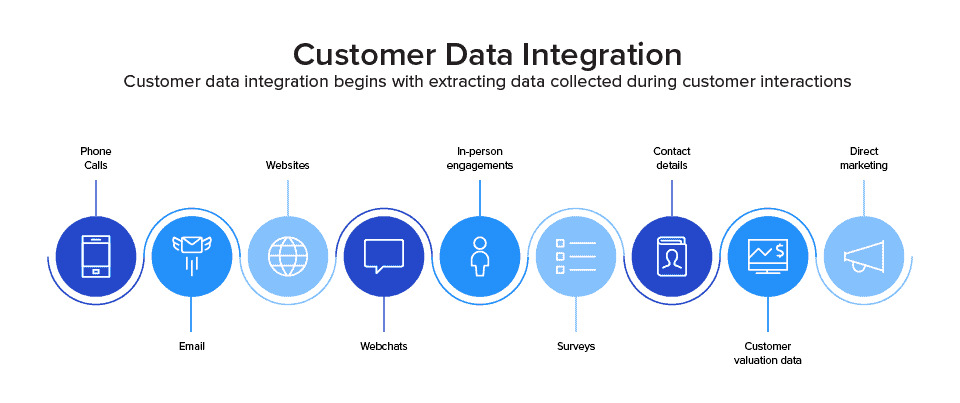What is Customer Data Integration (CDI)?
Your sales team has captured a new customer. How often does your data have to be entered into an application before your organization can interact with them? How certain are you that their details will be safely, securely, and compliantly maintained?
Customer Data Integration (CDI) is the practice of capturing, synching, and maintaining information about website visitors, leads, customer interactions, customer incidents, financial data, customer requests, and actions across your product and service portfolio. CDI allows your tools and teams to seamlessly transact business without having data redundancy or data inconsistency errors. Your customer data can be integrated into applications and services regardless of the format while making use of cloud storage data lakes. CDI integration is the facilitation of turning data into information on what your customer expects from you currently and into the future.
CDI benefits from cloud services interacting with internet-based products (SaaS) but beware as this may introduce data fraud or hacking. As CDI practices mature, the ability for your staff to collaborate with a customer is enhanced. Customer data integration supported by cloud and SaaS provides a 360-degree view of your customers and their impact upon your business activities in a commonly accessible single source of truth.

Why is Customer Data Integration so Important?
The global pandemic changed everything about how people work, play, and shop, with studies indicating that more than a billion transactions occurred over the internet during the pandemic. Before COVID, how a customer interacted with a competitor was difficult to ascertain. Now the internet is your primary resource on how customer activities and desires.
Your applications need to pull this information in real-time such that product changes can be quickly introduced (agile development). In-house technology rarely has the computing or storage power to perform CDI adequately. Therefore, a cloud-first strategy linked to the internet is the new business paradigm towards creating better ways of working and satisfying customers and staff (becoming digital). The nirvana dream that all the data you require can be readily accessible is now within reach.
Without senior executives acknowledging and funding this strategy, the chance of your business going out of business is, unfortunately, your future. CDI tools, operated by your technology teams or a partner, will create a cost-effective Customer Data Platform (CDP), which feeds sales, personalized marketing, service management, and financial reviews with minimal effort.
Benefits
Many organizations are experiencing these outcomes as they move to cloud-based customer data integration:
- Ease of New Products or Enhancements: decisions that drive what price or product your customers use or when they would benefit from a more personalized choice linked to agile DevOps availability and service management
- Avoidance of Data Duplication and Inconsistencies: Caused by manual entry or poor data application conversion
- Improved Customer Service Experiences: CDI provides real-time information on how customers are being impacted by issues allowing quick response or status update communications
- Future Sales or Marketing Insight: It is one thing to react to what is happening today. It is far better to assuredly predict what will attract and retain the customers of tomorrow. CDI presents to your company a combined view of your performance versus competitors or future trends.
- Customer Integrated Data Strategy is a Marketing Bonus: Your customers will feel how you care for them if they know their data is safe and secure.
- Business Recoverability: Facilitated by not having a plethora of data sources to replace, which also lessens your business insurance!
Challenges
- Creating a Knowledge Database of Your Data and its Use: If you don’t know where your data is used, then how can you create and maintain a data strategy? Think of all of the Excel versions of data within your teams. The Lean or DevOps practice of Value Stream Management to ascertain who is doing what, when and how data and technology is helping them will assist in designing a common data repository of information flow and quality.
- Integration of Historical Customer Data with Your Current Software: information kept for regulatory reasons must be accessible as your software services change.
- Data Sources Are Vast in Number and Type: the internet provides a constant flow of information from mobile devices, IoT, various service tools, global regulation changes, and more. Your CDI tools must capture, approve access and use, and place in your data lake for cloud product accessibility.
- A Data Warehouse is Not Data Integration: information in a warehouse is precisely mapped and managed by a defined application. Integration implies that any software can use the data within your organization. Thus, a single repository such as a data lake must be utilized.
- Avoidance of Data Silos: one application says customers are First Name-Last Name while the other states that customer is Last Name-First Name and voila, you have two data silos. Upon reflection, you have many more silos as your other applications treat this customer differently because of this disparity. Your goal is to avoid silos as they will degrade customer ability, satisfaction, and your product decision-making.
According to Harvard Business Review, only 3% of companies meet basic quality standards!
Best Practices of Customer Data Integration
- Know what you have and how it is used and maintained.
- Know what you need to keep and why to keep you in business and compliant.
- Automate all data movement.
- Try to create as few data warehouses or lakes as possible to facilitate data management or GDPR compliance.
- Audit, monitor, and alert all data access, capture, movement, backup, and archive.
- Remove duplication of data use or entry.
- Stop integrating the capabilities of your tools and instead focus on incorporating the attributes of your data to facilitate service and product management or everyday business tasks.
- Constantly understand and know where your data is or how it is being used. If your cloud or SaaS provider has an issue, contractually ensure you are notified within an agreed timeframe.
Minimally customer data integration involves:
- Data consolidation where you create a single repository, such as a data warehouse, data marts, or data lakes.
- Data propagation where your applications pull or push data from a variety of sources.
- Data federation which is software that places your data into a virtual location for use and then removes it based upon parameters such as time.
- Privacy and protection of customer data from breaches (internal or external) or non-compliant management.
A true 360-degree view of a customer can’t be sourced exclusively from internal data let alone from a single system or department. Organizations trying to correlate customer interactions, transaction history, and behaviors to improve customer acquisition ROI and retention struggle to aggregate and analyze data and signals across operational, social engagement, customer experience, and outreach systems to provide real-time customer insights.
The Actian Data Platform allows organizations to apply real-time analytics to rapidly aggregate customer profiles and personalize the customer experience



